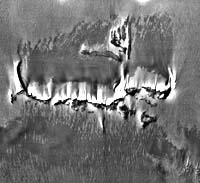| . |  |
. |
Melvin Christensen of Kyle, Sask. found a strange seven-kilogram 'rock' while cultivating land about 20 years ago. The heavy, black rock piqued the interest of Andrew Bird, a third-year geology student at the University of Calgary, who was hosting a Prairie Meteorite Search "show and tell" on July 3 at the Kyle museum. Bird was examining rocks that local residents thought could be meteorites. "It was in the back of your mind that it just didn't look like a rock that should be here," he says. "It was heavy with the black crust that looked like it had been melted." Christensen put the strange rock in the gazebo at his farmstead where it sat for two decades. "The first thing that struck me was the perfect fusion crust and the dished surface typical of meteorites, however, this meteorite had a hole through it the size of a quarter," says Bird. "This is the first stone I know of to have a hole." By chance, U of C planetary scientist Alan Hildebrand, one of the project leaders of the Prairie Meteorite Search, visited Bird later that day, and was puzzled by the unusual surface on the dense and magnetic stone. Tests at the U of C showed that the meteorite was 25 per cent nickel-bearing metal -- an unambiguous indication of a rock from space. Its extraterrestrial identity was then confirmed by John Wacker of the Pacific Northwest Laboratory, located in Washington, who detected signs of the meteorite's exposure to cosmic rays during its long journey in space to Saskatchewan. The meteorite has a flattened pyramidal shape, and is covered with hollows and a black fusion crust from surface melting as friction slowed it in the upper atmosphere. Cutting the meteorite revealed a very unusual texture of coarse fragments mixed with a fine grained melted matrix. "This texture may represent a mixture of melt and broken fragments produced by a large impact on the meteorite's parent asteroid," says Hildebrand, a professor in the Department of Geology and Geophysics. "This odd-ball texture will make the meteorite an interesting study, and will provide one more clue about what the rest of our solar system is like." This is the 13th new meteorite recovery in Saskatchewan. Alberta is Canada's current leading province with 14 recoveries. The Prairie Meteorite Search locates meteorites by encouraging prairie farmers to have rocks identified that they suspect to be meteorites. The project consists of local publicity campaigns and visits to towns with meteorite specimens to show local residents. The project relies on people actually having seen meteorites and the possibility of immediate identification to make discoveries. "Farmers have been very responsive to the search and keenly interested in meteorites," says Bird. "With their help we look forward to identifying more this summer." About a dozen unconfirmed new meteorites are thought to be in the hands of farming families across the prairies. The Prairie Meteorite Search hopes to find four of them this summer. Anyone who believes that they have meteorite is encouraged to bring it forward. The Prairie Meteorite Search is a project of the Meteorites and Impacts Advisory Committee to the Canadian Space Agency. This is Canada's volunteer group charged with the investigation of fireballs and the recovery of meteorites. Additional project funding comes from the Canadian Society of Exploration Geophysicists, the Natural Sciences and Engineering Research Council, and the University of Calgary. The project leaders are Alan Hildebrand, University of Calgary; Peter Brown, University of Western Ontario, and Martin Beech, University of Regina.
Related Links  Alexandria - August 1, 2000 Alexandria - August 1, 2000Space Adventures, the world's only space tourism company, announced today the immediate availability of seven places on its first expedition to the frozen continent of Antarctica. The voyage will mark the first time private individuals will specifically seek the retrieval of Martian-origin meteorites.
|
| ||||||||||
| The content herein, unless otherwise known to be public domain, are Copyright 1995-2016 - Space Media Network. All websites are published in Australia and are solely subject to Australian law and governed by Fair Use principals for news reporting and research purposes. AFP, UPI and IANS news wire stories are copyright Agence France-Presse, United Press International and Indo-Asia News Service. ESA news reports are copyright European Space Agency. All NASA sourced material is public domain. Additional copyrights may apply in whole or part to other bona fide parties. Advertising does not imply endorsement, agreement or approval of any opinions, statements or information provided by Space Media Network on any Web page published or hosted by Space Media Network. Privacy Statement All images and articles appearing on Space Media Network have been edited or digitally altered in some way. Any requests to remove copyright material will be acted upon in a timely and appropriate manner. Any attempt to extort money from Space Media Network will be ignored and reported to Australian Law Enforcement Agencies as a potential case of financial fraud involving the use of a telephonic carriage device or postal service. |